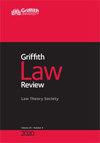Murderesses, monsters and madwomen: gender performance and the assessment of queer culpability in the Australian legal imagining
IF 0.9
Q1 LAW
引用次数: 0
Abstract
ABSTRACT The socio-legal tendency to categorise female killers as either ‘mad’, ‘sad’ ‘bad’ has been recognised as reflective of narrow notions of women’s capacity for violence. If women only kill due to insanity, or as the result of prior victimisation (the ‘mad’ and ‘sad’), then those who fall outside this narrative (the ‘bad’) risk legal and popular characterisation as non-women and even non-human. I consider the role of gender performance in which of these narratives are imposed upon a defendant and suggest that queer women are particularly susceptible to framing as monstrous due to their transgression of gender norms. This article will focus on the murders of Edward Baldock and Stacey Mitchell, both killed by lesbian couples in Australia in 1989 and 2006 respectively. Despite the intervening years, the defendants in both were characterised as vampiric in court and the news media, to the exclusion of relevant evidence of mental illness. I will examine this discursive and textual construction of the lesbian offender through Julie Kristeva’s theory of abjection and explore how the creation of a legal monster justifies, and indeed necessitates, its expulsion from society, leading to harsher punishment for lesbian defendants.杀人犯、怪物和疯女人:性别表现和澳大利亚法律想象中的酷儿罪责评估
社会法律倾向于将女性杀手归类为“疯狂”,“悲伤”,“坏”,这被认为是对女性暴力能力的狭隘观念的反映。如果女性杀人只是因为精神错乱,或者因为之前的受害者(“疯狂”和“悲伤”),那么那些不在这种叙述范围内的人(“坏人”)就有可能被法律和大众定性为非女性,甚至非人类。我考虑了性别表现的作用,在这些叙事中,这些叙事被强加在被告身上,我认为酷儿女性特别容易被诬陷为怪物,因为她们违反了性别规范。这篇文章将重点关注爱德华·巴尔多克和斯泰西·米切尔的谋杀案,他们分别于1989年和2006年在澳大利亚被女同性恋夫妇杀害。尽管相隔多年,两起案件的被告在法庭和新闻媒体上都被定性为吸血鬼,排除了精神疾病的相关证据。我将通过朱莉·克里斯特娃(Julie Kristeva)的堕落理论来研究这种对女同性恋罪犯的话语和文本建构,并探索一个法律怪物的创造如何证明,实际上是必要的,将其驱逐出社会,导致对女同性恋被告的更严厉惩罚。
本文章由计算机程序翻译,如有差异,请以英文原文为准。
求助全文
约1分钟内获得全文
求助全文

 求助内容:
求助内容: 应助结果提醒方式:
应助结果提醒方式:


